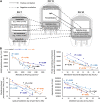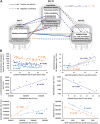The time-course linkage between hemolysis, redox, and metabolic parameters during red blood cell storage with or without uric acid and ascorbic acid supplementation
- PMID: 37025499
- PMCID: PMC10072267
- DOI: 10.3389/fragi.2023.1161565
The time-course linkage between hemolysis, redox, and metabolic parameters during red blood cell storage with or without uric acid and ascorbic acid supplementation
Abstract
Oxidative phenomena are considered to lie at the root of the accelerated senescence observed in red blood cells (RBCs) stored under standard blood bank conditions. It was recently shown that the addition of uric (UA) and/or ascorbic acid (AA) to the preservative medium beneficially impacts the storability features of RBCs related to the handling of pro-oxidant triggers. This study constitutes the next step, aiming to examine the links between hemolysis, redox, and metabolic parameters in control and supplemented RBC units of different storage times. For this purpose, a paired correlation analysis of physiological and metabolism parameters was performed between early, middle, and late storage in each subgroup. Strong and repeated correlations were observed throughout storage in most hemolysis parameters, as well as in reactive oxygen species (ROS) and lipid peroxidation, suggesting that these features constitute donor-signatures, unaffected by the diverse storage solutions. Moreover, during storage, a general "dialogue" was observed between parameters of the same category (e.g., cell fragilities and hemolysis or lipid peroxidation and ROS), highlighting their interdependence. In all groups, extracellular antioxidant capacity, proteasomal activity, and glutathione precursors of preceding time points anticorrelated with oxidative stress lesions of upcoming ones. In the case of supplemented units, factors responsible for glutathione synthesis varied proportionally to the levels of glutathione itself. The current findings support that UA and AA addition reroutes the metabolism to induce glutathione production, and additionally provide mechanistic insight and footing to examine novel storage optimization strategies.
Keywords: accelerated aging; ascorbic acid; glutathione; oxidative stress; red blood cell; storage lesion; uric acid.
Copyright © 2023 Anastasiadi, Stamoulis, Papageorgiou, Lelli, Rinalducci, Papassideri, Kriebardis, Antonelou and Tzounakas.
Conflict of interest statement
The authors declare that the research was conducted in the absence of any commercial or financial relationships that could be construed as a potential conflict of interest. The reviewer ADA declared a past co-authorship with the authors MHA to the handling Editor.
Figures




References
-
- Anastasiadi A. T., Tzounakas V. L., Arvaniti V. Z., Dzieciatkowska M., Stamoulis K., Lekka M. E., et al. (2021). Red blood cell proteasome in beta-thalassemia trait: Topology of activity and networking in blood bank conditions. Membr. (Basel) 11 (9), 716. 10.3390/membranes11090716 - DOI - PMC - PubMed
-
- Anastasiadi A. T., Arvaniti V. Z., Paronis E. C., Kostomitsopoulos N. G., Stamoulis K., Papassideri I. S., et al. (2022). Corpuscular fragility and metabolic aspects of freshly drawn beta-thalassemia minor RBCs impact their physiology and performance post transfusion: A triangular correlation analysis in vitro and in vivo . Biomedicines 10 (3), 530. 10.3390/biomedicines10030530 - DOI - PMC - PubMed
LinkOut - more resources
Full Text Sources

